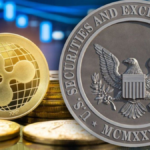- The US Federal Reserve made a significant move with its first interest rate cut since 2020.
- Instead of the anticipated 25 basis points (bps), it opted for a larger 50 bps reduction, bringing the rates to 4.75%-5%.
The Official Announcement
In a press release, the US Federal Reserve announced that the Federal Open Market Committee (FOMC) now possesses “greater confidence that inflation is moving sustainably toward 2 percent.” They also noted that the committee is making progress in balancing the risks associated with inflation and employment. Consequently, they decided to lower interest rates by 50 bps to a range of 4.75%-5%.
The US central bank aims to achieve maximum employment along with a long-term inflation rate of 2%. However, it emphasized that its economic outlook continues to hold uncertainty. Therefore, the “Committee is attentive to the risks to both sides of its dual mandate.”
Further Interest Rate Reductions Ahead
The Fed indicated that additional adjustments to interest rates could be considered. However, any such moves will hinge on forthcoming data, market perceptions, and emerging risks following the FOMC’s recent decision.
The committee will specifically analyze the impact of its decision on the labor market, inflation risks and expectations, along with financial conditions both domestically and internationally.
Experts Weigh In
The lowered borrowing costs certainly provide businesses with an chance to take on more debt at reduced interest rates, which can be leveraged to enhance their capital. This may also enable them to expand their workforce, thereby increasing their operational capacity and profits.
Conversely, this development renders savings accounts and low-yield investments less appealing. Consequently, investors may shift their focus toward stocks or other assets with higher returns but greater risks, such as cryptocurrencies.
Experts quoted by AP News suggest that a cut in interest rates may not instantly lead to lower mortgage or auto loan rates. However, its effects will inevitably extend to these areas over time. Those likely to benefit the most are borrowers with strong credit ratings.
Additionally, financial analysts recommend that individuals avoid holding onto cash that is not urgently needed. In such instances, it might be smarter to invest their funds in options yielding “decent returns” or in longer-term certificates of deposit.
Moreover, credit card users could take advantage of the scenario by consolidating their debts through 0% balance transfer credit cards or by opting for personal loans with low interest rates.
Bitcoin’s Performance
As anticipated, the Fed’s announcement of a more aggressive easing policy drove individuals to safeguard their wealth using hard assets like Bitcoin (BTC). Following the FOMC’s decision, the leading cryptocurrency saw fluctuations exceeding 5%, ranging from a low of $59,218.25 to a high of $62,578.77. As of 5:00 AM UTC, it sustained gains above 2%, fluctuating around the $62K mark.
The positive shift in cryptocurrency market sentiment was reflected in the most recent updates in the multifactorial Crypto Fear & Greed Index, which moved from a 45-point “Fear” level yesterday to today’s 49 points, indicating a shift to “Neutral” territory.








